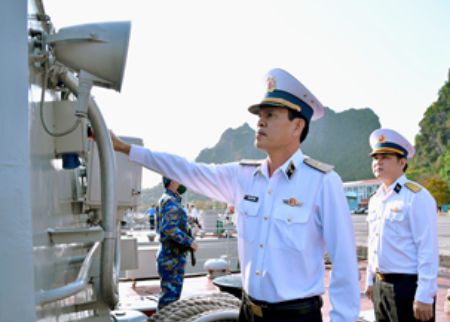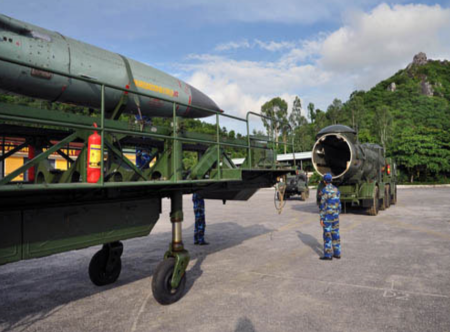Training and combat readiness is the central political task and important content decisive to the overall quality and combat power of agencies and units. It is also an important and regular task that has been led and directed by the 1st Naval Region's Party Committee and Command through multiple synchronous and effective solutions to meet the requirements and tasks of protecting sovereignty over the sacred sea and islands of the Fatherland.
To fulfil the tasks of training and combat readiness, managing and protecting the waters and islands in the Gulf of Tonkin, participating in search and rescue operations at sea, and other irregular tasks, for the past years, the 1st Naval Region's Party Committee and Command have focused on leading and directing to improve the quality of training, and level of combat readiness to contribute to fulfiling all assigned tasks. Notably, as the Region has directed agencies and units to thoroughly grasp and strictly implement the superiors’ resolutions and directives on training and combat readiness, the awareness of its cadres and soldiers for this task has constantly been raised.
 |
| 1st Naval Region's Commander checks equipment before training |
Importance has regularly been attached to the preparation of training in terms of personnel, facilities, and training grounds. The renovation of direction, administration, contents, programs, and methods of training for the objects have seen positive changes. Particularly, attention has been paid to night training and field training in the Spratly Islands and under complicated weather conditions in association with performing patrol, reconnaissance, management, and protection tasks in the assigned waters and islands. In the training process, the 1st Naval Region's Party Committee and Command have creatively and effectively applied viewpoints, mottos, principles, combinations, regimes, and regulations; carried out the prevention, control, and safe adaptation to each level of the Covid-19 pandemic; flexibly adjusted and supplemented plans and schemes; and strictly maintained orders and regimes of combat readiness duty of radar stations, technical reconnaissance stations, etc. not to be made passive or surprised in any situation. Besides, they have well performed the Party and political work in training and combat readiness; combined education to raise awareness and sense of responsibility for the soldiers with promoting the Determination-to-Win emulation movement in association with implementing the superiors’ resolutions and directives on promoting learning and following Ho Chi Minh’s thoughts, ethics, and style and the Drive entitled “promoting tradition, dedicating talents, and being worthy of the title “Uncle Ho's Soldier - Naval Soldier” in the new period; and assured adequate weapons, technical equipment, ships, boats, ... to serve training, combat readiness, and other unexpected tasks. Accordingly, the quality of training has been gradually improved. Many units of the Region have been awarded the Flag of Excellent Training Unit by the Ministry of National Defence and the Service.
In the coming time, the situations in the region and the world in general and the East Sea in particular will still be complicated and unpredictable with many potential risks of instability; meanwhile, the task of protecting the country's sovereignty over sea and islands has developed. Therefore, it poses increasingly high demands on the Service in general and the 1st Naval Region in particular. To fulfil the task of protecting the country's sovereignty over sea and islands, the 1st Naval Region's Party Committee and Command have focused on leading and directing the synchronous and comprehensive implementation of solutions to improve the quality of training, qualifications, and combat readiness, especially the following basics:
Firstly, to strengthen education and raise awareness and sense of responsibility for cadres and soldiers towards training and combat readiness. This is the fundamental solution that determines the completion of the Region’s central political task as, only with the right awareness and high sense of responsibility, will the soldiers have the courage and determination to overcome all sacrifices and hardships to fulfil all assigned tasks. Therefore, agencies and units need to continue thoroughly grasping and effectively implementing the superiors’ resolutions, directives, and orders on training and combat readiness, particularly Conclusion No.60-KL/QUTW issued on January 18th, 2019 by the Central Military Commission on continuing to implement Resolution No.765-NQ/QUTW; Instruction No.14/CL-BQP issued on March 28th, 2017 by the Minister of National Defence; and the Service Commander’s Order of combat training. Thereby, it is necessary to focus on educating the soldiers to be aware of the position, meaning, and importance of training and combat readiness and firmly grasping the characteristics of tasks, contents, programs, targets, and requirements to be achieved to raise awareness, sense of responsibility, and determination to fulfil tasks. Due to the characteristics of the Navy’s training and combat readiness, training and performance of tasks in a harsh environment require the Party committees and commanders of agencies and units to strongly renovate the educational contents, forms, and methods towards in-depth, substance, effectiveness, and relevance directions; strengthen measures to improve the qualifications, capacity, and experience in soldier education for grassroots cadres and new graduates to apply in practice; combine education with ideological management and orientation for soldiers; focus on timely and thoroughly solving problems arising in daily life and creating a healthy, democratic, and cultural environment for soldiers to work with peace of mind, enthusiasm, high sense of responsibility, and attachment to the units; and promote the regular Determination-to-Win emulation movement and peak emulation sessions in training, combat readiness, and building comprehensively strong units in association with drives and movements of all levels and branches to motivate, cheer, and encourage the soldiers to strive to fulfil the training and combat readiness task.
 |
| Brigade 679 conducts missile training |
Secondly, to actively renovate training contents, programs, organisational forms, and methods. With the determination to take the task of protecting the Fatherland’s sovereignty over sea, islands, and continental shelf and building the “revolutionary, regular, elite, and modern” Service and Region as the training objectives, the Region should direct agencies and units to take the initiative in comprehensively renovating training towards actively applying information technology and simulation technology in training; adhering to the viewpoints, principles, and mottos in training; considering battlefields as training grounds; and taking tactical training as the centre, specialised techniques as the basis, and cadre training as the key which are relevant to the responsibilities and tasks. For the contingent of cadres, the Region should focus on training to improve the level of advice, proposal, handling of incidents, and ability to command and manage agencies and units. Regarding professional and technical staff, the Region should attach importance to training to make them the units’ “backbone” with high workmanship and qualifications to be capable of mastering specialised skills in exploiting weapons and technical equipment, especially the new ones. For warship, shore missile, marine, and radar units, the Region should promote basic training to master combat plans and specialised techniques and strengthen night training and training in complicated weather conditions to challenge soldiers in difficult, arduous, and practical situations. Along with that, the Region should direct agencies and units to continue promoting the implementation of the breakthrough in exploiting and using weapons and technical equipment, implementing safety rules, and improving the quality of officer training, commanding, and physical training and sports”; associate training with competitions and contests; and strengthen inspection, examination, and review to evaluate the actual results of training.
Thirdly, to focus on improving the qualifications and level of combat readiness. This is an important and indispensable content that is always associated with the training process of the Region. The good implementation of this content will directly contribute to the timely and effective handling of unexpected situations at sea not to be passive or surprised. Accordingly, the Region should thoroughly communicate and effectively implement the superiors’ documents and instructions on combat readiness; actively coordinate and cooperate with relevant units and forces, especially the Coast Guard, Fisheries Surveillance, Border Guard, etc. in managing and firmly protecting the sovereignty of the seas and islands under its control; direct the patrol and reconnaissance forces to firmly grasp the situation in the air and sea and promptly approach, propagate, and chase away foreign ships encroaching on Vietnam's waters; closely coordinate with the navies of the relevant countries in strictly implementing the joint maritime patrol plans; combine adjustment and supplementation with the construction of new documents, plans, and short-term and long-term combat schemes and organise practice and rehearsals; regularly raise vigilance and readiness to successfully handle situations and tasks; strictly maintain orders and modes of commanding, guard, and combat readiness duty as prescribed and organise the forces to practice mastering the combat readiness state changing steps, particularly the shore missile, marine, and warship ships; and continue directing to assure adequate of troops, weapons, ships, and boats for the units, with priority being put on patrolling, reconnaissance, and maritime management forces and forces on secret duty.
Finally, to ensure adequate and timely technical and logistical supply for training and combat readiness. To complete the key political tasks, agencies and units, especially technical agencies at all levels, need to improve their capacity of advising and directing units to assure adequate and synchronised weapons, technical equipment, ships, and vehicles for training and combat readiness; focus on the training of crews who upgrade weapons and ammunition and load torpedo bullets and missiles to ships and forces on maritime duty; implement orderly and effectively the regimes and regulations on technical work; and combine preservation and maintenance with management and effective exploitation of weapons, equipment, vehicles, ships,... under the content of the Drive 50 to contribute to improving the quality of training and combat readiness. In addition, the Region should direct agencies and units to assure adequate and timely logistics supplies for training and combat readiness task, especially focusing on guiding measures to ensure food hygiene and safety and take care of soldiers' health; develop plans of logistics assurance for forces performing secret tasks and long-term training at sea; and promote the implementation of emulation movement entitled “The Military Logistics follows Uncle Ho's teachings” to contribute to improving the overall quality and combat power of the Region to meet the requirements and tasks of protecting the country's sovereignty over sacred sea and islands.
Rear Admiral NGUYEN VIET KHANH, Region Commander